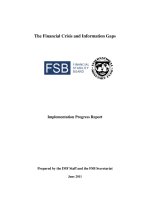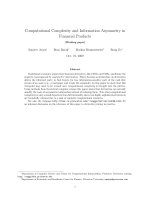CIM revision cards marketing research and information by john williams
Bạn đang xem bản rút gọn của tài liệu. Xem và tải ngay bản đầy đủ của tài liệu tại đây (3.07 MB, 131 trang )
CIM REVISION CARDS
Marketing Research and Information
John Williams
AMSTERDAM l BOSTON
PARIS l SAN DIEGO l
HEIDELBERG
SAN FRANCISCO
l
l
l
LONDON l
SINGAPORE
l
NEW YORK
SYDNEY
l
l
OXFORD
TOKYO
Elsevier Butterworth-Heinemann
Linacre House, Jordan Hill, Oxford OX2 8DP
30, Corporate Drive, Burlington, MA 01803
First published 2004
Copyright ß 2004, Elsevier Ltd. All rights reserved
No part of this publication may be reproduced in any material form (including photocopying or storing in any medium by electronic means
and whether or not transiently or incidentally to some other use of this publication) without the written permission of the copyright holder
except in accordance with the provisions of the Copyright, Designs and Patents Act 1988 or under the terms of a licence issued by the
Copyright Licensing Agency Ltd, 90 Tottenham Court Road, London, England W1T 4LP. Applications for the copyright holder’s written
permission to reproduce any part of this publication should be addressed to the publisher.
Permissions may be sought directly from Elsevier’s Science & Technology Rights Department in Oxford, UK: phone: (+44) 1865 843830,
fax: (+44) 1865 853333, e-mail: You may also complete your request on-line via the Elseiver homepage
(), by selecting ‘Customer Support’ and then ‘Obtaining Permissions’
British Library Cataloguing in Publication Data
A catalogue record for this book is available from the British Library
Library of Congress Cataloging in Publication Data
A catalogue record for this book is available from the Library of Congress
ISBN 07506 62891
For information on all Elsevier Butterworth-Heinemann publications visit our website at
Printed and bound in Great Britain
TABLE OF CONTENTS
1.
2.
3.
4.
5.
6.
7.
8.
9.
10.
11.
12.
Preface ........................................................................... iv
Marketing research and information .......................................... 1
Information in the knowledge economy ...................................... 11
The marketing database ....................................................... 28
The marketing research process .............................................. 40
Using secondary research...................................................... 61
Observation research ........................................................... 67
Qualitative research............................................................. 75
Quantitative data ................................................................ 84
Questionnaire design ........................................................... 94
Sampling ......................................................................... 104
Quantitative data analysis ...................................................... 112
Presenting marketing research ................................................ 121
Bibliography ..................................................................... 125
PREFACE
Welcome to the CIM Revision Cards from Elsevier/Butterworth–Heinemann. We hope you will find these useful to
revise for your CIM exam. The cards are designed to be used in conjunction with the CIM Coursebooks from
Elsevier/Butterworth–Heinemann, and have been written specifically with revision in mind. They also serve as
invaluable reviews of the complete modules, perfect for those studying via the assignment route.
n Learning outcomes at the start of each chapter identify the main points
n Key topics are simmarized, helping you commit the information to memory quickly and easily
n Examination and revision tips are provided to give extra guidance when preparing for the exam
n Key diagrams are featured to aid the learning process
n The compact size ensures the cards are easily transportable, so you can revise any time, anywhere
To get the most out of your revision cards, try to look over them as frequently as you can when taking your CIM
course. When read alongside the Coursebook they serve as the ideal companion to the main text. Good luck –
we wish you every success with your CIM qualification
MARKETING RESEARCH AND
INFORMATION
INTRODUCTION
The Marketing Research and Information
module has five major components:
å
å
å
å
å
Information and research for decision-making
Customer databases
Marketing research in context
Research methodologies
Presenting and evaluating information to
develop business advantage
Syllabus Reference: 1.1–1.4
Unit 1
INFORMATION AND RESEARCH FOR
DECISION-MAKING
Marketers have more information than ever before,
but poor decisions and failure to meet customers’
needs still occur. This element of the syllabus
explores information management and the way in
which organizations should determine their
marketing information requirements, in order to
drive profitable lasting relationships with
customers. It covers the nature of the technical
systems that are available to marketers to
manage information and support decision-making.
The next few pages give an overview of the
syllabus
MARKETING RESEARCH AND INFORMATION
1
MARKETING RESEARCH AND INFORMATION
2
Customer Databases
See the diagram on page 3.
Syllabus Reference: 2.1–2.5
Example
TGI customer database
TGI is a research service run by BMRB. In this example it is run against an internal database and common
characteristics identified.
The First T Process TGI and the Database. Source: Clive Humby BMRB
MARKETING RESEARCH AND INFORMATION
3
MARKETING RESEARCH AND INFORMATION
4
Marketing Research in Context
Syllabus Reference: 3.1–3.6
The nature, size and scope of the market
research industry, including the suppliers of
research services and providers of database and
other information services. The stages of a
research programme and the procedures and
briefing of external agencies.
The ability to get the best from suppliers is a key
part of the manager’s job and is also true for
market research. Communicating a research
problem and inspiring an agency to produce a
thoughtful, well-structured research plan, is crucial
to the process of decision-making.
The ethical and social responsibilities of the
researcher, as laid down within the codes of
conduct and legislation considerations
Research Methodologies
Syllabus Reference: 4.1–4.6
These elements of the syllabus deal with the marketing research task and the methods that support the
research process. They cover the range of methods and techniques that underpin good research design.
Key capabilities include asking the right questions and using data to inform decision-making to reduce the
risk to the business. Current techniques draw heavily on the internet, but there is a need to distinguish good
from poor data.
The syllabus distinguishes between qualitative and quantitative research and the range of techniques that
are used to gather this information; for example, questionnaires and topics guide design and delivery to
support research design and analysis.
MARKETING RESEARCH AND INFORMATION
5
MARKETING RESEARCH AND INFORMATION
Presenting and Evaluating Information to Develop Business Advantage
Syllabus Reference: 5.1–5.3
This part of the syllabus looks at the evaluation and presentation of research data and conclusions. It
covers the techniques that are used in the analysis of quantitative and qualitative data and the production
of written research reports and oral presentations of the results. The key aim of the module is to ‘provide
the knowledge and skills to manage marketing information, and the more specialist knowledge and skills
required to plan, undertake and present results from market research’ (CIM, 2003).
Related statements of marketing practice
These statements link the syllabus to the tasks of the marketing professional. The ones that apply to this
module are:
l
l
l
The evaluation of information requirements, the management of research projects and the marketing
information system
The evaluation and presentation of information for business advantage
The ability to contribute information and ideas to the strategy process
6
LEARNING OUTCOMES
å If you understand the learning outcomes of the module then you have a clear idea of what the examiners will be looking
for in your assessment.
Learning Outcomes and Knowledge and Skills Requirements
Contd.
MARKETING RESEARCH AND INFORMATION
7
MARKETING RESEARCH AND INFORMATION
Contd.
8
I
MARKETING RESEARCH AND INFORMATION
9
MARKETING RESEARCH AND INFORMATION
10
Hints and Tips
n Show the examiner that you understand the basis of the question, by answering precisely the question
asked and not including just about everything you can remember about the subject area
n Read their needs – How many points is the question asking you to address?
n Respond to the question appropriately. Is the question asking you to take on a role? If so, take on the role
and answer the question with respect of the role
n Ensure the examiner has something to mark: give them substance, relevance, definitions,
illustrations and demonstration of your knowledge and understanding of the subject area
n Provide a strong sense of enthusiasm and professionalism in your answers; support it with relevant
up-to-date examples and apply them wherever appropriate
n Collect examples of the application of models, techniques, concepts, etc.
n Make sure that you are able to apply your learning to actual marketing situations and issues.
Go to www.cimvirtualinstitute.com and www.marketingonline.co.uk for additional support and guidance
INFORMATION IN THE
KNOWLEDGE ECONOMY
Unit 2
KEY POINTS
n At the heart of successful enterprises is the
effective management of information
n Integrated information is critical to effective
decision-making. Advantage in the market
place does not come just from carrying out
research, it is about identifying, collating,
understanding, analyzing and acting upon the
many diverse sources of knowledge and
information within an organization
n Many organizations are not organized to
manage this process effectively
å To manage information effectively, many
organizations need to undergo a significant
cultural change. In particular, there is a need
for co-operative and collaborative attitudes
towards sharing information and knowledge
å However, many find this change difficult to
manage. Information may exist in silos that are
not connected, leading to critical gaps in
understanding
MARKETING RESEARCH AND INFORMATION
11
INFORMATION IN THE KNOWLEDGE ECONOMY
Marketing Research (Dibb, Simkin, Pride and Ferrell, 2000)
Collection of marketing information
Answers the questions – What, where and when are customers buying? etc.
n How do we compare with our competitors? etc.
n Why do customers respond to this form of sales promotion? etc.
n What would happen if the government introduced new legislation in this area, etc.
Typical data: market analysis
n Market profitability
n Market growth trends
n Main products in the market
n Customer attitudes and buying behaviours
n Major competitors and market shares
n Distribution patterns
n Marketing strategies used in the market
12
Typical data: product research
n New products
n Gap between current products and perception
n Consumer research
n Research from international markets
n Competitor research
n Long-range economic studies
n Satisfaction levels and trends with current products
Typical data requirements: pricing decisions
n Competitor product prices
n Consumer attitudes to price
n What would they expect to pay?
n What would they be prepared to pay?
n Cost price volume – what quantities are likely to sell at different price levels?
MARKETING RESEARCH AND INFORMATION
13
INFORMATION IN THE KNOWLEDGE ECONOMY
Typical data requirements: advertising and promotion
n Size of potential market
n Demographic characteristics of users
n Demographic profiles of segments
n Behaviours and attitudes of different segments
n Language used by customers in talking about product
n Share of mind compared with competitors
Typical data requirements: sales decisions
n Sales territories
n Sales personnel efficiency
n Sales statistics
n Sales forecasts
n Sales incentives
14
The knowledge age
l
Huge volumes of information now available
l
Managers need to be selective and systematic
l
As data is drawn from multiple sources, it needs to be combined and analyzed for it to be of value
Knowledge management
n The aim is to integrate systems and individuals to enable and encourage knowledge transfer between
employees and other stakeholders.
n Knowledge involves organizing, interpreting and analyzing information to produce intelligence.
n Knowledge within organizations can take many forms:
• Individual knowledge: resides in the mind of an individual.
• Organizational knowledge: interactions between technologies, techniques and people.
• Explicit knowledge: documented and shared through IT, externalized and conscious. Marketing research
data is a good example of this type of knowledge.
• Tacit knowledge: hard to codify and document because individuals often take for granted what they know
and how they do things. It can be difficult to communicate what they know in a form that others can use
effectively.
MARKETING RESEARCH AND INFORMATION
15
INFORMATION IN THE KNOWLEDGE ECONOMY
The Structure of an Information System
Technology infrastructure
Hardware
Systems software
Applications
Software
Communications
Personnel
Technology developers
Systems operators
Systems maintainers
Data infrastructure
Users
Databases
User support
Database management
Archiving communication
16
Marketing management support systems – The marketing information system (MKIS)
This is a system in an organization that supplies information, communication services and resources to
meet organizational needs. The MkIS is the system used to put information at the heart of the decisionmaking process. A typical MkIS consists of four elements:
n
n
n
n
The marketing research system is the backbone of the marketing information system
The marketing intelligence system – published data existing in the market place
The decision support system – contains the tools needed to make sense of data
Internal records – includes e.g. sales and accounts records, details on past communications and the
results of previous marketing research
MARKETING RESEARCH AND INFORMATION
17
INFORMATION IN THE KNOWLEDGE ECONOMY
The Marketing Information System (MkIS)
18
What is Marketing Research?
The Market Research Society (MRS) defines it as ‘the collection and analysis of data from a sample of
individuals or organizations relating to their characteristics, behaviour, attitudes, opinions or possessions.
It includes all forms of marketing and social research, such as consumer and industrial surveys,
psychological investigations, observational and panel studies’ (MRS, 1999)
Marketing research is the function that links the consumer, customer and public to the marketer through
information. . . it specifies the information required to address these issues, designs the method for collecting
information, manages and implements the data collection process, analyses the results, and
communicates the findings and their implications (American Marketing Association, 2003)
Market research is a subset of marketing research. Market research refers to research on markets,
whereas marketing research covers the broad scope of marketing activity
MARKETING RESEARCH AND INFORMATION
19
INFORMATION IN THE KNOWLEDGE ECONOMY
20
Databases
A database does not have to be computer-based but access to database technology is easy and cheap.
A database will collect data about past, potential and current customers. A database differs from an accounting
system in that the data must be relevant to marketing decision-making. It is important that data fed into the
marketing database is relevant to marketing decisions, now and in the future.
Wilson (2003) suggests that marketers develop customer databases for four reasons:
1. To personalize marketing communications
2. To improve customer service
3. To understand customer behaviour
4. To assess the effectiveness of the organization’s marketing and service activities.









